 Dear Wisconsin nursery growers, Christmas tree growers, and gardeners,
Below are growing season updates from the Wisconsin Department of Agriculture, Trade and Consumer Protection’s (DATCP) Bureau of Plant Industry.
For those of you attending the Wisconsin Christmas Tree Producers Association meeting August 19-21 in Merrill, we look forward to seeing you soon and discussing the implications of recent regulatory changes, including the addition of Eau Claire and Richland Counties to the quarantine area for Lymantria dispar (formerly known as gypsy moth), and the recent federal deregulation of pine shoot beetle in late 2020.
Please send any feedback, questions, or ideas you have for future e-news updates to datcpnurservy@wisconsin.gov.
Having trouble viewing this email? View it as a Web page.
Lace Bug Damage Detected on River Birch
There are about 50 species of lace bugs in the genus Corythucha (Order Hemiptera, Family Tingidae) in the U.S. Some can cause damage to nursery stock and tree hosts, including alder, birch, crabapple and hawthorn, as they feed with piercing-sucking mouthparts on leaf undersides, especially in mid-summer. Moderate amounts of lace bug feeding damage was visible on River Birch leaves at a nursery dealer in Eau Claire County, July 7, 2021. The leaves upper surface looked mottled white and the leaf undersides were infested with gray, lacy-winged flattened adults and spiny nymphs, feeding on leaf sap, taking away the green coloring and leaving their feces as black deposits. Lace bug damage can cause early leaf drop and become unsightly, but impacted hosts usually keep enough of their leaves to avoid serious damage. Foliar insecticides can suppress populations for several weeks if applied early, such as when foliage is still expanding in May; as well as during mid-season when all life stages are present.
BELOW: River Birch with Lace Bug adults and nymphs, Konnie Jerabek; Jim Baker, North Carolina State University, Bugwood.org
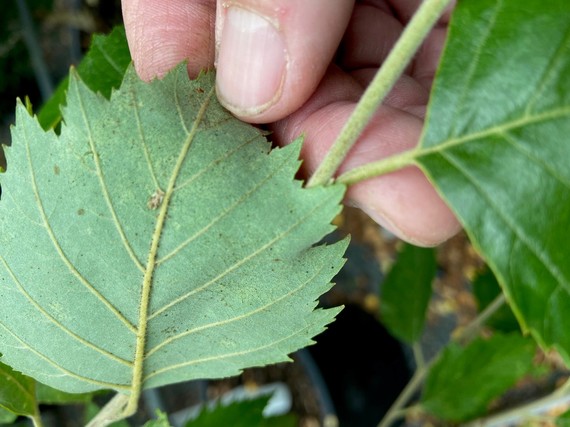 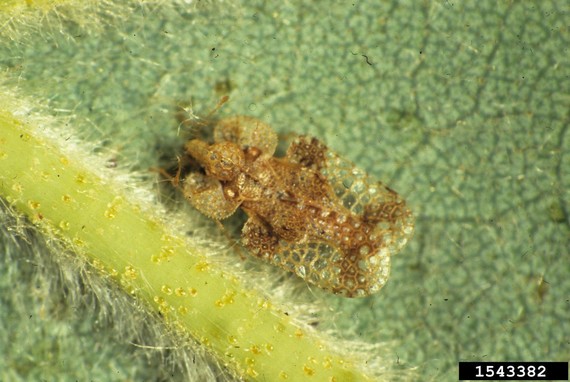 Spotted Lanternfly Inches Closer to Wisconsin’s Border with Recent Indiana Detection
The spotted lanternfly (Order Hemiptera: Family Fulgoridae) Lycorma delicatula is a planthopper that threatens grapes, hops, hardwoods (especially tree-of-heaven), walnut, and maple. Both spotted lanternfly nymphs and adults suck sap from plant stems, leading to reduced photosynthesis, decline, and death. Honeydew excreted by the spotted lanternfly promotes black sooty mold fungi and may attract other insect pests like wasps or bees. Since 2014, populations have been detected in Connecticut, Delaware, Indiana, Maryland, New Jersey, New York, Ohio, Pennsylvania, Virginia, and West Virginia. Many of these states are attempting to contain spotted lanternfly through exterior and interior quarantine regulations. Wisconsin is in the process of revising our plant pest rule known as ATCP 21 to consider enacting a spotted lanternfly exterior quarantine here. In July, we learned that a substantial population of the spotted lanternfly was detected for the first time on a wooded residential property in Switzerland County, Indiana, near the Ohio River and Kentucky border. Indiana Department of Natural Resources (DNR) and U.S. Department of Agriculture (USDA) staff are now surveying to determine the extent of the infestation and to devise management strategies for this invasive pest. As we head into late summer and fall when spotted lanternfly adults emerge, swarm, mate, and lay eggs, it is more important than ever to be on the lookout for this pest and report it to the pest hotline at 866-440-7523 or datcppesthotline@wisconsin.gov. More information about spotted lanternfly is available at slf.wi.gov
BELOW: Image of Spotted Lanternfly, Lawrence Barringer, Pennsylvania Department of Agriculture, Bugwood.org
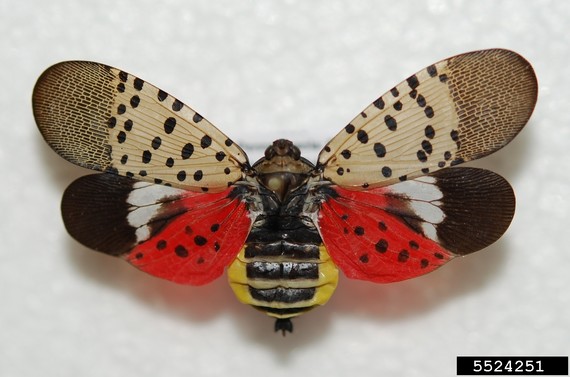
Yellow-Headed Spruce Sawfly Feeding in Large Numbers on Colorado Blue Spruce
The yellow-headed spruce sawfly, Pikonema alaskensis (Order Hymenoptera: Family Tenthredinae) is a native pest that feeds on white, black, and blue spruce. Adults look like small (8-10mm) reddish brown wasps, and the larvae, which are about twice as large, are recognized by their yellow heads and striped green bodies. Sawflies always have six or more pairs of prolegs without crochets (and they are not killed by the insecticide Btk), while caterpillars that turn into butterflies or moths have five or fewer pairs of prolegs with crochets, or tiny hooks. Adults lay eggs in current year’s needles and larvae hatch and feed for 4-6 weeks in May and June (with young larvae preferring new growth and older larvae eating older foliage when that is the only available option). Heavy feeding can make the tree look brown, and heavy loss of needles reduces tree vigor and overall health. Larvae can kill spruce if they eat all the needles, or by feeding on the same tree for 2-3 seasons in a row. An inspector in northwestern Wisconsin observed larvae feeding in moderate to heavy numbers on Colorado blue spruce needles in Polk County earlier this spring and summer. You can help by scouting for sawfly feeding damage in mid-May through June. Look for missing needles on the newest shoots. You may be able to minimize damage if you catch it early. Insecticidal soap can control young yellow-headed spruce sawfly larvae, residual insecticides can control older stages, and physically removing larvae can be effective. Their numbers may continue to increase in local areas, so it helps to reduce their numbers on your ornamental landscape trees.
BELOW: Image of Yellow-Headed Spruce Sawfly, Konnie Jerabek
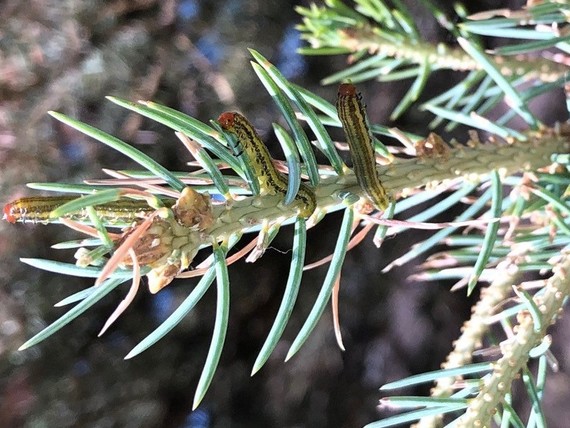
Red-Headed Flea Beetles Observed on Hydrangea and Weigela throughout Wisconsin
Red-headed flea beetle (Order Coleoptera: Family Chrysomelidae) Systena frontalis adults were detected feeding in moderate to heavy numbers at nurseries across Wisconsin over the past couple weeks. The adult flea beetle is shiny black with a reddish head and back jumping legs. Adult beetle feeding causes brown patches to form on the upper and lower leaf surfaces. The sun will burn a hole through the browned leaf tissue, leaving a lacey or skeletonized look to the leaves. Larvae, which feed on roots upon emerging from overwintering eggs in June, are cream-colored, 5-10 mm long, with a diagnostic fleshy projection on their last abdominal segment. The red headed flea beetle prefers to feed on Weigela, dogwood, and hydrangea leaves, with some cultivars preferred over others. It has a broad host range overall, and can also be a pest of cranberries (its other common name is the cranberry flea beetle), blueberries, and alfalfa. The inspector at this nursery dealer location found ‘Golden Jackpot’ Weigela, ‘Quick Fire,’ ‘Vanilla Strawberry,’ ‘Bobo,’ and ‘Strawberry Sundae’ hydrangeas to be particularly preferred by these flea beetles, which can actively feed between July and September. Heavy feeding damage will reduce aesthetic quality of ornamental plants. Red headed flea beetle feeding damage in nursery setting has been more noticeable the past several years. Common weeds like jewelweed can also be hosts so removing any weeds nearby can be a good way to reduce alternate food sources, which will hopefully reduce populations of this pest.
BELOW: Image of Red-headed flea beetle, Konnie Jerabek
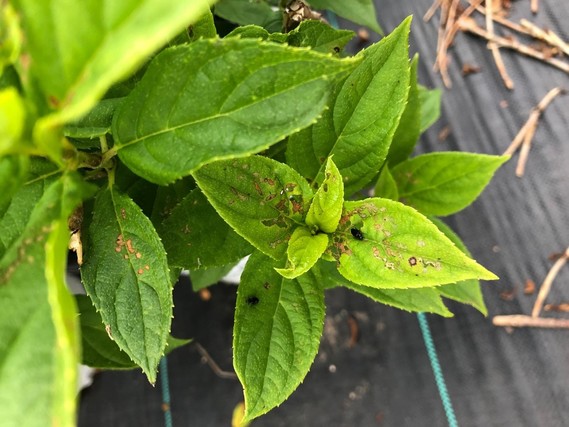
Box Tree Moth Poses A New Threat to Boxwood in US
Boxwood is an iconic, economically valuable nursery ornamental valued at approximately $750 million per year in the U.S. Unfortunately, boxwood has come under siege recently by diseases like boxwood blight, and now, the box tree moth. Earlier this spring, the U.S. had its first detection of the box tree moth when infested boxwood was sent from Canada to at least six states. Stock was then sold online or distributed directly to consumers from receiving locations. The good news is that almost all of this stock was inspected, removed, and destroyed. USDA’s Animal and Plant Health Inspection Service (APHIS) has also issued a federal order prohibiting the importation of boxwood, holly, and euonymous (all box tree moth hosts) from Canada in an attempt to prevent box tree moth’s establishment. All 10 potentially infested boxwood that were comingled with infested stock at a South Carolina nursery before being sold online to Wisconsin consumers, were removed by DATCP staff from residences in Kenosha, Waukesha, Neenah, and Coloma in June. No evidence of box tree moth was found on those boxwood or surrounding hosts, and all plant material was double-bagged and destroyed by APHIS following laboratory examination. Box tree moth larvae are yellow, black, and green striped caterpillars that tend to leave webbing on plants as they feed. Feeding causes defoliation and dieback of host plants. Keep an eye on any of your host plants for this new pest and if found, please report it to us at datcppesthotline@wi.gov. Check out the APHIS box tree moth webpage for more information on this invasive pest.
BELOW: Left, Box tree moth caterpillars or larvae. Christophe Quintin via Flickr, used under a CC BY-NC 2.0 license; Middle, Box tree moth adult. Alison Morris, Bugwood.org; Right, Boxwood plant removed from residence
 Learn More
More information about Wisconsin's Nursery Program: Nursery and Christmas Tree Program Webpage
Division of Agricultural Resource Management | Bureau of Plant Industry
Having trouble viewing this email? View it as a Web page.
|